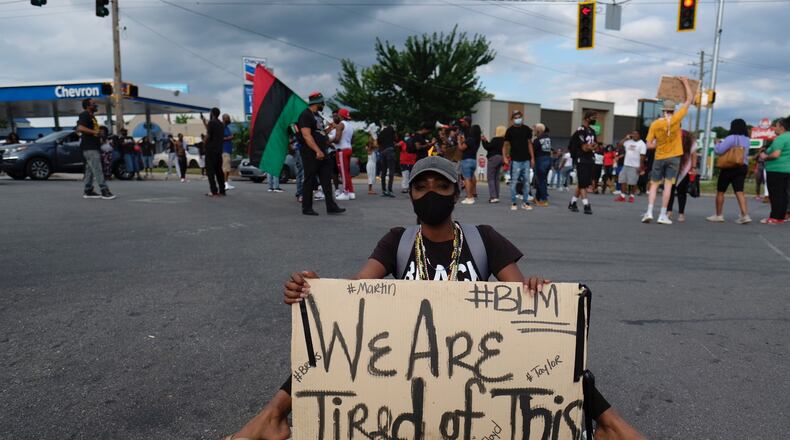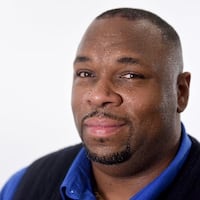In a fight-or-flight response, muscles tense as breathing quickens. The heart thumps uncontrollably. Sweat likely becomes visible as stress hormones are triggered from psychological reactions.
In other words, experts say, your body fights for your life.
These moments have been playing out across the country, often in recordings as people press play on cell phone cameras determined to catch the injustice du jour as it is happening.
Eric Garner screamed “I can’t breathe” while in a New York City police officer’s chokehold in July 2014. George Floyd called for his deceased mother on Memorial Day as a Minneapolis officer held a knee to his neck.
On June 12, Rayshard Brooks’ moment came after an Atlanta Police officer abruptly grabbed his left arm to handcuff him amid an encounter in a south Atlanta Wendy’s parking lot, after having made casual conversation for much of 40 minutes.
“Then comes the fight or flight,” metro Atlanta psychotherapist Joyce Morley said recently. “The officer engaged [Brooks] and crossed the line that says ‘you can trust me.’ He allowed that officer into his house. Then, out of the clear blue, ‘you betrayed me and now you’re going to handcuff me?’ When you’re looking at the position that he was in, his greatest fear was probably imagined.”
Many on social media argue the police case, that a compliant Brooks might still be alive today — if only he hadn’t run from the law.
However, according to experts in both trauma and police use of force, the way the scene unfolded as well as the complicated relationship between black people and law enforcement, may not allow for simple conclusions.
Brooks' reason for fleeing police that night will never be known, but a constant among the experts interviewed by The Atlanta Journal-Constitution was that he likely acted out of fear that he could die like Floyd, who lost consciousness while pinned under the Minneapolis officer's knee nearly 9 minutes.
“There is a long history of fear of the police, and rightfully so, in the black community,” said Roxanne Donovan, a professor of psychology and interdisciplinary studies at Kennesaw State University. “That fear is heightened because these things are now on social media and black people are bearing witness to something that they knew was happening. When we’re facing abject fear, we have a physiological response that is almost immediate.
“Our bodies can respond before we have a cognitive response about what to do.”
The video documenting the last moments of Brooks’ life show him casually talking to the two Atlanta Police officers for much of 40 minutes after a Wendy’s employee called police saying someone fell asleep in the fast-food eatery’s drive-thru line.
Officer Devin Brosnan found Brooks, parked in a white Toyota Camry, with cars going around Brooks’ to order their food. Brooks failed several field sobriety tests, officers said.
The other officer — Garrett Rolfe — abruptly grabs the left arm of the 27-year-old Brooks to place him in handcuffs. Brooks fights Rolfe and Brosnan, then tries to run away.
Seconds later, Brooks was dead, shot twice in the back by Rolfe.
“He thought that he could trust those officers,” said Richard Nobles, a black clinical psychologist with Truman Medical Center in Kansas City, Mo., “and [that moment] was as if he was being set up for the kill, both literally and figuratively. This goes back to the beginnings of interactions between us as people that came here and [white people], the people who brought us here. It’s baked like sugar into a cake. And then there are all these contextual factors that have been added to over time that garnish and enhance what goes on.”
The officers are now charged in Brooks' death, with Rolfe facing a count of felony murder and various charges of aggravated assault, violating the oath of office and damage to property. Brosnan faces several charges of aggravated assault and violating the oath of office.
Brooks’ death has sparked widespread protesting in Atlanta, on the heels of protests begun after Floyd’s death on May 25 in Minnesota.
Morley, also a member of the DeKalb County Board of Education, said Brooks was lulled into a vulnerable space through calm conversations that did not foretell of Rolfe moving to place him in handcuffs.
“He was not expecting to be arrested,” Morley said. “They had entertained him. When they went to handcuff him, he probably thought about George Floyd. Everything is going to come up. What about my kids? What about my wife? He really thought by being nice, he’d be fine. They tell them not to run, but George Floyd didn’t run. Breonna Taylor didn’t run. Eric Garner didn’t run. He’s not thinking about the end result.
“He’s just thinking about getting away.”
High stakes for everyone
According to public records, Brooks was recently arrested in January, and on probation until 2026. That also could have factored into what he did after police announced he would be placed under arrest, Nobles said.
“Even though he was inebriated, that doesn’t mean he did not have all his faculties,” Nobles said. “He certainly could have had that as a consideration. Especially if he was on probation, he would not have wanted to be arrested — even on a DUI — because that would jeopardize his probation.”
Michael Dorn, a 25-year law enforcement veteran who consults on use of force and other safety training, said while he cautions anyone watching footage from Friday night’s incident not to rush to judgment, he was bothered by perceived gaps in the efforts the officers used to maintain control of the situation.
Dorn noted the way Brosnan first approached Brooks' vehicle as not being guarded enough, how Brosnan leaves Brooks by himself to greet Rolfe as he arrives, as well as the fact that Brosnan allowed Brooks to move his own car from the drive-thru line despite believing Brooks was inebriated.
"We talk about officers overreacting, but it's often from underreacting before they get to that point," said Dorn, currently the executive director for Safe Havens International, which has done security assessments for more than 6,000 K-12 schools in 24 countries. "The best way to survive a gunfight is to never get into one. You have to exert a certain level of control when you encounter people."
Dorn said while a Taser’s blast is not likely to kill someone, the device can still be used to get someone off balance. That also could factor into decisions made by the officers on June 12.
“If you’re a cop and I’m a suspect, I get your Taser and tase you, I can make you incapacitated and kill you,” he said. “That’s a very real concern. The reason we train so much is this is high-stakes we put [officers] in.”
About the Author
Keep Reading
The Latest
Featured


